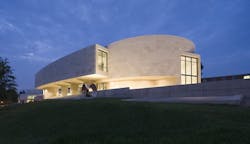EYP, WHR Architects merge, strengthening presence in education, healthcare, energy sectors
EYP and WHR Architects, two internationally recognized design firms, have merged to better serve today’s most pressing public and private building infrastructure needs: education, healthcare and energy. The strategic alliance provides unparalleled access to integrated thought leadership and high-performance design capabilities, regardless of client location.
The merger continues the expansive growth that both EYP and WHR have experienced in an increasingly competitive architecture and engineering market. In 2013, EYP grew by 20 percent and opened six new offices and WHR grew by 70 percent. Both firms’ continuing growth demonstrates the power of knowledge leadership to add exponential value in the architecture and engineering design market. The EYP and WHR merger unites 530 professionals to form a seamless innovation culture.
EYP, the national leader in sustainability with high-performance projects in over 100 countries, delivers expertise-driven designs to higher education, government, energy, and corporate clients. Prior to joining forces with WHR, EYP expanded its family of practices in 2013 with the addition of The Weidt Group, an energy consulting and software firm with offices throughout the Midwest. Renowned in the higher education and government sectors, EYP is ranked No. 1 for sustainable design by Architect magazine, and No. 4 in higher education and No. 5 in federal government in Building Design+Construction’s nationwide Giants 300 list.
Houston-based WHR, with additional offices in Dallas and Copenhagen, currently employs approximately 170 staff. WHR, the healthcare design firm of choice for the world’s leading medical center, is responsible for several of the largest current healthcare projects in the country. (Based on Architectural Record’s data on healthcare construction starts between January 2013 and February 2014.) WHR is ranked No. 1 in healthcare renovation in Health Facilities Management Magazine, September 2014.
“EYP and WHR are united by passion and purpose, fueled by research and focused on furthering our clients’ missions. They trust us to help them make well-informed decisions that will advance their vision and create lasting value,” said Tom Birdsey, AIA, President and CEO of EYP. “Understanding the intersection of technology, human experience, and the natural environment is key to building a more sustainable world and advancing a new paradigm for our profession. Our merger positions us to better help our clients negotiate this challenging landscape, and our increased national visibility will allow us to further expand our reach and continue to provide valued insight for clients in the healthcare, higher education and energy industries, among others.”
“As design professionals, we are uniquely positioned to help preserve and advance our culture in ways that enable individuals to prosper, including the transformation of the healthcare experience,” said David Watkins, FAIA, Chairman of WHR. “The culture and expertise WHR shares with EYP gives us the ability to help our clients better achieve their missions. I look forward to what this partnership holds for our future growth – as two design thought leaders, our strategic alliance offers public and private sector clients greater access to specialized expertise and expanded resources. The knowledge, tools and services EYP provides will be a crucial asset in helping clients embrace sustainability and collaborative design excellence.”
ABOUT EYP
EYP is a renowned global provider of high-performance building design, research, and consulting services to higher education, government, healthcare, and corporate clients. The company provides seamless project delivery with access to the award-winning expertise and resources of its family of practice groups, which includes sustainable design leader EYP Architecture & Engineering; WHR Architects, healthcare design specialists; and The Weidt Group, building energy performance specialists. More than 530 professionals in architecture, engineering, energy, and interior design collaborate across 15 offices in the United States and Europe to deliver expertise-driven design. For more information, visit http://eypaedesign.com/.
ABOUT WHR
WHR, based in Houston, Texas, with additional offices in Dallas and Copenhagen, Denmark, is a full-service architecture and interior design firm, currently ranked No. 1 in healthcare renovation and the 13th largest healthcare practice in the United States. The firm’s commitment to critical thinking is balanced by an ingrained empathy that results in both improved project outcomes and positive working experiences for their clients. With over 170 people firm-wide, the 35-year-old firm is working on projects worldwide for toptier public and private education and medical institutions. WHR is one of EYP’s practice groups. For more information about WHR Architects, visit http://www.whrarchitects.com.
ABOUT THE WEIDT GROUP
The Weidt Group, a practice group of EYP, was established in 1977 to account for and manage the environmental impacts of building design and construction. Working with architects, engineers, building owners, utilities, and government clients, The Weidt Group is an expert in improving building performance over time through energy modeling, benchmarking, measurement and verification, and software development. For more information, visit www.twgi.com.
